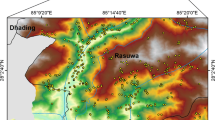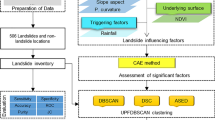Abstract
Because of the strong dependence on the values for the input parameters and the cluster shape, as well as the difficulties in quantifying the precipitation in constructing landslide susceptibility maps by employing existing clustering algorithms, we propose a novel method based on an Ordering Points to Identify the Clustering Structure (OPTICS) algorithm using the Hausdorff distance (OA-HD). The OA-HD algorithm distributes mapping units into many subclasses with similar characteristic values for topography and geology. To obtain more optimal subclasses, the HD was adopted to quantify precipitation. The K-medoids algorithm grouped these subclasses into five susceptibility levels according to the values of landslide density in each subclass. Applying the innovative integrated algorithms to the study area significantly improves the landslide susceptibility assessment, especially in a large study area. The method suggests new insights for better assessing landslide susceptibility in a large study area.














Similar content being viewed by others
References
Abdollahi S, Pourghasemi HR, Ghanbrian RS (2018) Prioritization of effective factors in the occurrence of land subsidence and its susceptibility mapping using an SVM model and their different kernel functions. Bull Eng Geol Environ 78(6):4017–4034
Al M, Jang DH, Park J (2017) Comparison of logistic, Bayesian, and Maxent models for prediction of landslide distribution. Journal of The Korean Geomorphological Association 24(2):91–101
Althuwaynee OF, Pradhan B, Park HJ, Lee JH (2014) A novel ensemble decision tree-based Chi-squared automatic interaction detection (CHAID) and multivariate logistic regression models in landslide susceptibility mapping. Landslides. 11(6):1063–1078
Ankerst M, Breunig MM., Kriegel, HP, Sander JS (1999) OPTICS: ordering points to identify the clustering structure. Proceedings of the ACM SIGMOD International Conference on Management of Data
Ba QQ, Chen YM, Deng SS, Wu QJ et al. (2017) An improved information value model based on gray clustering for landslide susceptibility mapping. International Journal of Geo-Information 6(1):18
Bezdek JC, Ehrlich R, Full W (1984) FCM: the fuzzy c-means clustering algorithm. Comput Geosci 10(2–3):191–203
Bui D, Shahabi H, Shirzadi A, Chapi K et al (2018) Landslide detection and susceptibility mapping by AIRSAR data using support vector machine and index of entropy models in Cameron Highlands, Malaysia. Remote Sens 10(10):1527
Chen YL, Chen DH, Chun LZ, Huang JB (2016) Preliminary studies on the dynamic prediction method of rainfall-triggered landslide. J Mt Sci 13:1735–1745
Chen W, Peng JB, Hong HY, Shahabi H et al. (2018) Landslide susceptibility modelling using GIS-based machine learning techniques for Chongren County, Jiangxi Province, China. Science of the Total Environment 626:1121–1135
Cheng MY, Hoang ND (2016) Slope collapse prediction using Bayesian framework with K-nearest neighbor density estimation: case study in Taiwan. J Comput Civ Eng 30(1)
De Carvalho F, De Souza R, Chavent M, Lechevallier Y (2006) Adaptive Hausdorff distances and dynamic clustering of symbolic interval data. Pattern Recogn Lett 27:167–179
Ding MT, Hu KH (2014) Susceptibility mapping of landslides in Beichuan County using cluster and MLC methods. Natural Hazard 70:755–766
Firomsa M, Abay A (2019) Landslide assessment and susceptibility zonation in Ebantu district of Oromia region, western Ethiopia. Bull Eng Geol Environ 78(6):4229–4234
Gorsevski PV, Brown MK, Panter K, Onasch CM et al. (2016) Landslide detection and susceptibility mapping using LiDAR and an artificial neural network approach: a case study in the Cuyahoga Valley National Park, Ohio. Landslides 13:467–484
Guo P, Meng XM, Li YJ (2015) Effect of large dams and irrigation in the upper reaches of the Yellow River of China, and the geohazards burden. Proc Geol Assoc 126:367–376
Huang L, Xiang LY (2018) Method for meteorological early warning of precipitation-induced landslides based on deep neural network. Neural Process Lett 48:1243–1260
Huang Y, Zhao L (2018) Review on landslide susceptibility mapping using support vector machines. Catena. 165:520–529
Jaafari A, Gholami DM, Zenner EK (2017) A Bayesian modeling of wildfire probability in the Zagros Mountains,Iran. Ecological Informatics 39:32–44
Karypia G, Han EH, Kumar V (1999) Chameleon: a hierarchical clustering algorithm using dynamic modeling. Computer 32:68–75
Kato T, Hirata T, Saito, T, Kise K (1996) An efficient algorithm for the Euclidean distance transformation. Systems and Computers in Japan 27(7):18–24
Kaufman L, Rousseeuw PJ (1990) Finding groups in data: an introduction to cluster analysis. J Am Stat Assoc
Khosravi K, Pham BT, Chapi K, Shirzadi et al (2018) A comparative assessment of decision trees algorithms for flash flood susceptibility modeling at Haraz watershed, northern Iran. Sci Total Environ 627:744–755
Kinoshita N, Endo Y (2014) EM-Based clustering algorithm for uncertain data. Knowledge and Systems Engineering 245:69–81
Kumar D, Thakur M, Dubey CS, Shukla DP (2017) Landslide susceptibility mapping & prediction using support vector machine for Mandakini River Basin, Garhwal Himalaya,India. Geomorphology 295:115–125
Luo W, Liu CC (2018) Innovative landslide susceptibility mapping supported by geomorphon and geographical detector methods. Landslides. 15:465–474
Mao YM, Zhang MS, Wang GL, Sun PP (2015) Landslide hazards mapping using uncertain Naïve Bayesian classification method. J Cent South Univ 22:3512–3520
Mao YM, Zhang MS, Sun PP, Wang GL (2017) Landslide susceptibility assessment using uncertain decision tree model in loess areas. Environ Earth Sci 76:752–770
Markus R, Gustau CV, Bjorn S (2019) Deep learning and process understanding for data-driven earth system science. Nature 566(7743):195–204
Melchiorre C, MatteucCi M, Azzoni A, Zanchi A (2008) Artificial neural networks and cluster analysis in landslide susceptibility zonation. Geomorphology. 94(3–4):379–400
Meliho M, Khattabi A, Mhammdi N (2018) A GIS-based approach for gully erosion susceptibility modelling using bivariate statistics methods in the Ourika watershed, Morocco. Environ Earth Sci 77(18):655
Merwe DW, Van D, AP Engelbrecht (2004) Data clustering using particle swarm optimization. Proceedings of the IEEE Congress on Evolutionary Computation, Canerra, Australia
Olivier C, Andy M (2004) Performance of analysis of hierarchical clustering algorithm. J Classif 21:3–18
Ortiz JAV, Martinez-Grana AM (2018) A neural network model applied to landslide susceptibility analysis (Capitanejo, Colombia). Geomatics Natural Hazards & Risk 9:1106–1128
Othman AA, Gloaguen R, Andreani L, Rahnama M (2018) Improving landslide susceptibility mapping using morphometric features in the Mawat area, Kurdistan region, NE Iraq: comparison of different statistical models. Geomorphology. 319:147–160
Park SJ, Lee CW, Lee S, Lee MJ (2018) Landslide susceptibility mapping and comparison using decision tree models: a case study of Jumunjin area, Korea. Remote Sens 10(10):1545
Pradhan B (2013) A comparative study on the predictive ability of the decision tree, support vector machine and neuro-fuzzy models in landslide susceptibility mapping using GIS. Comput Geosci 51:350–365
Reichenbach P, Rossi M, Malamud BD, Mihir M et al (2018) A review of statistically-based landslide susceptibility models. Earth Sci Rev 180:60–91
Sahana M, Sajjad H (2017) Evaluating effectiveness of frequency ratio, fuzzy logic and logistic regression models in assessing landslide susceptibility: a case from Rudraprayag district, India. J Mt Sci 14:2150–2167
Saro L, Woo JS, Kwan-Young O, Moung-Jin L (2016) The spatial prediction of landslide susceptibility applying artificial neural network and logistic regression models: a case study of Inje, Korea. Open Geosciences 8:117–132
Torizin J, Wang LC, Fuchs M, Tong B et al (2018) Statistical landslide susceptibility assessment in a dynamic environment: a case study for Lanzhou City, Gansu Province, NW China. J Mt Sci 15(6):1299–1318
Vakhshoori V, Pourghasemi HR (2018) A novel hybrid bivariate statistical method entitled FROC for landslide susceptibility assessment. Environ Earth Sci 77(19):686
Wan SA (2013) Entropy-based particle swarm optimization with clustering analysis on landslide susceptibility mapping. Environmental Earth Science 68:1349–1366
Wan S, Yen JY, Lin CY, Chou TY (2015) Construction of knowledge-based spatial decision support system for landslide mapping using fuzzy clustering and KPSO analysis. Arab J Geosci 8:1041–1055
Wang LJ, Guo M, Sawada K, Lin J et al (2015) Landslide susceptibility mapping in Mizunami City, Japan: a comparison between logistic regression, bivariate statistical analysis and multivariate adaptive regression spline models. Catena. 135:271–282
Wang Q, Wang Y, Niu RQ, Peng L (2017) Integration of information theory, k-means cluster analysis and the logistic regression model for landslide susceptibility mapping in the Three Gorges area, China. Remote Sens 9:938
Wu XL, Ren F, Niu RQ (2014) Landslide susceptibility assessment using object mapping units, decision tree, and support vector machine models in the Three Gorges of China. Environ Earth Sci 71(11):4725–4738
Zhang MS, Liu J (2010) Controlling factors of loess landslide in western China. Environ Earth Sci 59:1671–1680
Funding
This study was supported by the National Natural Science Foundation of China (41562019, 41530640) and the National Key Research and Development Projects of China (2018YFC1504705).
Author information
Authors and Affiliations
Corresponding authors
Rights and permissions
About this article
Cite this article
Hu, J., Xu, K., Wang, G. et al. A novel landslide susceptibility mapping portrayed by OA-HD and K-medoids clustering algorithms. Bull Eng Geol Environ 80, 765–779 (2021). https://doi.org/10.1007/s10064-020-01863-2
Received:
Accepted:
Published:
Issue Date:
DOI: https://doi.org/10.1007/s10064-020-01863-2




